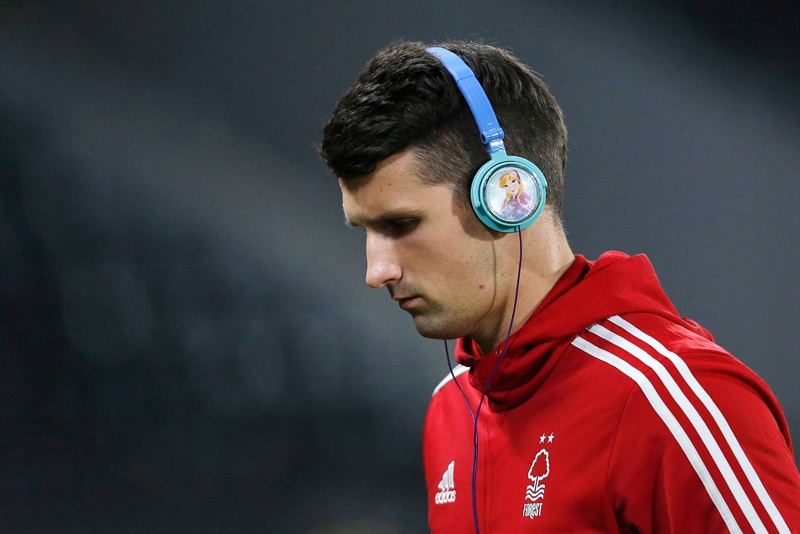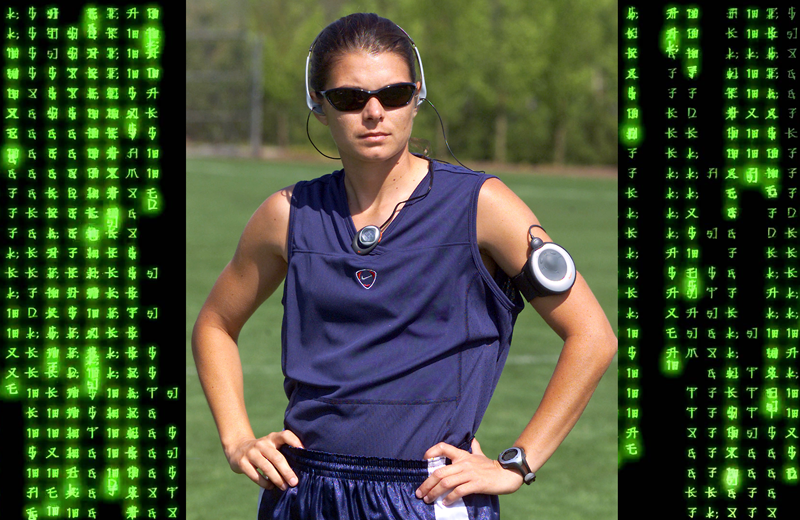Sport psychology researchers have recently sought to move from anecdotal to scientific knowledge in this area. The development of a scientific evidence base for the effects of music and motivational videos requires researchers to design appropriately controlled studies that seek to control for a number of factors that could affect the results. The scientific base for these new ideas is emerging with encouraging results from initial tests.
Cutting-edge research to investigate the effects of music on psychological states is led by my academic sparring partner and former Brunel University colleague, Dr Costas Karageorghis. Karageorghis suggests that music may elicit a number of psycho-physiological responses that lead to improved performance.
There are four main areas in which music may benefit performance:
1. Listening to music may narrow the attention of the performer, and consequently this could divert the performer’s attention away from feelings of tiredness and fatigue;
2. Listening to music also has an influence on arousal states, and hence, in pre-competition situations, may be used to stimulate or calm the performer;
3. Music has innate rhythmical qualities that individuals may respond to and which can make performing seem easier by allowing for the synchronisation and emulation of movement patterns to the music;
4. Listening to music may increase positive mood and decrease negative mood.
In a series of studies, research has demonstrated that listening to motivational music before performance is associated with increased strength (1).. Research has found that listening to music is associated with enhanced mood states, with listeners perceiving exercise to be less exhaustive (2).
- Rhythm response – music with a high tempo rhythm is good for high-energy tasks, while a slow rhythm is more suitable for low-energy tasks;
- Musicality – refers to the harmony and melody in the song;
- Cultural Impact – musical preference tends to be formed during adolescence and there are huge differences in personal preferences reflecting the age and background of listeners. For example, it’s not surprising that 19-year-old athletes tend to prefer different music to 30-year-old athletes. My preference is to listen to the Sex Pistols whilst exercising – a style of music not shared by many in the gym;
- Association – this relates to the time of release, whether the individual follows the music of the artist, or, as in the case of the theme tune to Rocky, powerful images are associated with the music.
The theoretical explanation for this effect, and one that is helpful in developing a way forward, is ‘self-regulation theory’. This is concerned with how people learn to change their emotions. Through experience, individuals learn to recognise the effects of what they do on how they feel and, importantly, become aware of this link.
It is important to recognise the individual nature of self-regulation theory and develop individually tailored interventions. For example, soul music might promote happiness for some people; heavy metal might make others happy. Two people may therefore select two completely different choices of songs or pieces of music when choosing music in terms of its ergogenic properties.
Susceptibility to music
In a study that asked athletes how they regulated unpleasant and potentially harmful mood states, athletes reported listening to music as a strategy for regulating anger, confusion, depression, fatigue and tension, and for raising vigour (5). However, an important point that also emerges from this study is that some athletes find music more influential than others. Selecting appropriate music for some athletes could lead to potent effects, and it is worth identifying these athletes before starting work.In an attempt to provide coaches with a scale to identify athletes who respond to music, as a strategy to enhance psychological preparation, a series of studies were conducted to develop a valid and reliable scale (6,7,8). This scale uses questions such as, ‘If you need to feel energetic, how effective is listening to music as a strategy to achieve this feeling?’ and, ‘If you are feeling worried, how effective is listening to music as a strategy to change this feeling?’ to assess how susceptible an athlete may be to music.
Case study
To illustrate how music can be integrated into an athlete’s preparation, I’ll use a case study from work with a professional boxer (9,10). We introduced music because the boxer found traditional relaxation techniques awkward and ineffective. Indeed, it transpired that he already used music to change his emotional states as a normal part of the training cycle and listened to music during the middle of the day to try to relax in between training sessions.Following exploration of the type of music that was effective, we developed a series of CDs to be used for relaxation. The growing use of portable MP3 players, which can store programmed music selections, means that athletes can now quite literally carry around their relaxation strategy.
The boxer also used music in the final stages of preparation for a World Championship contest. With a televised World Championship contest, a boxer will know the exact time of the fight and this allows the support team to develop carefully planned warm-up routines. This was something we developed and prepared for in the weeks leading up to the contest.
Music is an ideal medium around which to plan a warm-up routine. A two-hour build-up was developed, using music as the trigger to change what was happening during the warm-up:
- two hours before competition calming and relaxing music was played;
- 90 minutes before competition the music changed to more upbeat music;
- 45 minutes before competition, when the warm-up (both physically and psychologically) starts to build up, the music became more motivational and upbeat.
The music routine was integrated into the boxer’s final few training sessions, whereby the warm-up sequence was rehearsed before key sparring sessions. Fortunately, boxing lends itself to this approach because boxers compete far less often than tennis players do, for example (where this approach could be used for less important games rather than in training).
Discussions with the boxer revealed that listening to the theme tune played as he entered the ring generated moderate to intense emotions even if it was played away from competition. When his theme tune (‘Let me entertain you’ by Robbie Williams) came on the radio on the way to training, he went silent. ‘It takes me back to the moment I get in the ring,’ he said.
This is possibly not surprising as evidence shows that physical symptoms, or somatic anxiety, is at its highest shortly before competition, and therefore he would associate listening to the song with that period before competition. The music was used in conjunction with imagery sessions in which positive self-talk regarding the contest was rehearsed so that the athlete felt in control of his emotions as the music was played. When the theme tune is played shortly before competition it can help sharpen the athlete’s mind in preparation for the contest.
Video as an ergogenic aid
A strategy that can be used in conjunction with music is video footage. This work is being pioneered by Roberto Forzoni, a sport psychologist at the English Institute of Sport (11). Forzoni has developed relatively short video clips that are accompanied by an athlete’s preferred music, or music that targets a specific psychological state that could be used in training and before competition. Consistent with the ease with which music can be used in preparation through improved technology, many athletes have access to DVD players, often through their own laptop computer.Videotaped sessions of key training sessions and competition are extremely helpful in my work in professional boxing. Videotaping and analysing sparring and training sessions prove to be a very effective way of developing psychological skills. The boxer, coach and sport psychologist view videotape sessions on a 3ft-square screen in a lecture theatre at my university. These are then repeated throughout the programme.
Video analysis of the sparring sessions leads to detailed discussion on the strengths and limitations of performance, and the strengths and weaknesses of his opponent. For each opponent we would have details of the number of punches thrown for each 30 seconds of each round; ratio of head-to-body punches, the number of counter-punches that were thrown, jabs etc.
Regardless of the opponent, we observe that boxers tend to show consistent habits. For example, one boxer may move predominantly to one side and throw fewer punches in the first half of a round. This information was used as the basis for goal setting for technical sessions and imagery scenarios, while training was focused around exploiting the opponent’s weaknesses.
An aspect of developing personal motivational videos is the cost of equipment and time it takes to make the video. As computer technology becomes more sophisticated and computer memory becomes cheaper, the ability to put together three-minute clips with associated music becomes easier.
However, Forzoni does suggest that a downside to personal motivational videos stems from the time it takes to produce them. He allows a minimum of one hour for every minute produced, emphasising that this is minimum time. In a recent article in Sport and Exercise Scientist, he suggested 10 top tips to producing personal motivational videos. These are listed below:
Top 10 tips for producing effective personal motivational videos
- Keep the personal motivational videos short – three minutes is an ideal length.
- Use slow motion effects showing the athlete performing excellent skills.
- Show a close-up of the athlete’s face. This will arouse an emotional response making the personal motivational video a more powerful tool.
- Use inspirational music to score the personal motivational video. Combinations are endless.
- Use graphics to start the video, leading the athlete to the theme of the personal motivational videos, and then at appropriate points through the production.
- Use dissolve fades from normal to slow motion sequences to maximise the effects.
- Try to minimise the variety of special effects, particularly transitions (there is a temptation to use many different effects on the same personal motivational videos, which may reduce the impact of the message).
- Include short (10sec) clips of athlete-preferred role models where appropriate.
- Synchronise the video footage with the music score, and in particular the lyrics, where possible. Many fantastic opportunities to reinforce messages are missed when this synchronisation is not used and you will be amazed how many opportunities will occur to do this.
- Be prepared to invest time and experiment with clips, music and graphics to produce the ideal combination.
References
1. Percept & Motor Skills 1996; 83:1347-1352
2. J of Sport Behavior 1997; 20:54-68
3. J Sports Sci 1999; 17:713-24
4. J of Sports Sci (in press)
5. Athletic Insight 2001 www.athleticinsight.com/
Vol3Iss3/MoodRegulation.htm
6. J of Sports Sci 2005; 22:174-175
7. J of Sports Sci 2005; 22:175-176
8. J of Sports Sci 2005; 22:181-182
9. Athletic Insight (in press)
10. Paper presented at the European Colleges of Sport Sciences Conference, Salzburg, Austria, June 2003
11. The Sport and Exercise Scientist, March 2006











